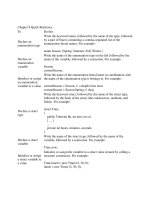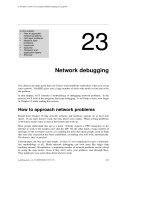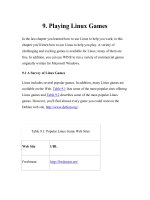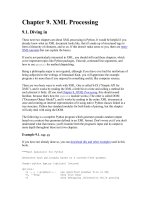Chapter 9 :Circuit Switching docx
Bạn đang xem bản rút gọn của tài liệu. Xem và tải ngay bản đầy đủ của tài liệu tại đây (282.39 KB, 34 trang )
William Stallings
Data and Computer
Communications
Chapter 9
Circuit Switching
Switching Networks
❚
Long distance transmission is typically done over a network of
switched nodes
❚
Nodes not concerned with content of data
❚
End devices are stations
❙
Computer, terminal, phone, etc.
❚
A collection of nodes and connections is a communications network
❚
Data routed by being switched from node to node
Nodes
❚
Nodes may connect to other nodes only, or to stations and other
nodes
❚
Node to node links usually multiplexed
❚
Network is usually partially connected
❙
Some redundant connections are desirable for reliability
❚
Two different switching technologies
❙
Circuit switching
❙
Packet switching
Simple Switched Network
Circuit Switching
❚
Dedicated communication path between two stations
❚
Three phases
❙
Establish
❙
Transfer
❙
Disconnect
❚
Must have switching capacity and channel capacity to establish
connection
❚
Must have intelligence to work out routing
Circuit Switching - Applications
❚
Inefficient
❙
Channel capacity dedicated for duration of connection
❙
If no data, capacity wasted
❚
Set up (connection) takes time
❚
Once connected, transfer is transparent
❚
Developed for voice traffic (phone)
Public Circuit Switched
Network
Telecomms Components
❚
Subscriber
❙
Devices attached to network
❚
Local Loop
❙
Subscriber loop
❙
Connection to network
❚
Exchange
❙
Switching centers
❙
End office - supports subscribers
❚
Trunks
❙
Branches between exchanges
❙
Multiplexed
Circuit Switch Elements
Circuit Switching Concepts
❚
Digital Switch
❙
Provide transparent signal path between devices
❚
Network Interface
❚
Control Unit
❙
Establish connections
❘
Generally on demand
❘
Handle and acknowledge requests
❘
Determine if destination is free
❘
construct path
❙
Maintain connection
❙
Disconnect
Blocking or Non-blocking
❚
Blocking
❙
A network is unable to connect stations because all paths are in
use
❙
A blocking network allows this
❙
Used on voice systems
❘
Short duration calls
❚
Non-blocking
❙
Permits all stations to connect (in pairs) at once
❙
Used for some data connections
Space Division Switching
❚
Developed for analog environment
❚
Separate physical paths
❚
Crossbar switch
❙
Number of crosspoints grows as square of number of stations
❙
Loss of crosspoint prevents connection
❙
Inefficient use of crosspoints
❘
All stations connected, only a few crosspoints in use
❙
Non-blocking
Crossbar Matrix
Multistage Switch
❚
Reduced number of crosspoints
❚
More than one path through network
❙
Increased reliability
❚
More complex control
❚
May be blocking
Three Stage Switch
Time Division Switching
❚
Partition low speed bit stream into pieces that share higher speed
stream
❚
e.g. TDM bus switching
❙
based on synchronous time division multiplexing
❙
Each station connects through controlled gates to high speed
bus
❙
Time slot allows small amount of data onto bus
❙
Another line’s gate is enabled for output at the same time
Routing
❚
Many connections will need paths through more than one switch
❚
Need to find a route
❙
Efficiency
❙
Resilience
❚
Public telephone switches are a tree structure
❙
Static routing uses the same approach all the time
❚
Dynamic routing allows for changes in routing depending on traffic
❙
Uses a peer structure for nodes
Alternate Routing
❚
Possible routes between end offices predefined
❚
Originating switch selects appropriate route
❚
Routes listed in preference order
❚
Different sets of routes may be used at different times
Alternate Routing Diagram
Control Signaling Functions
❚
Audible communication with subscriber
❚
Transmission of dialed number
❚
Call can not be completed indication
❚
Call ended indication
❚
Signal to ring phone
❚
Billing info
❚
Equipment and trunk status info
❚
Diagnostic info
❚
Control of specialist equipment
Control Signal Sequence
❚
Both phones on hook
❚
Subscriber lifts receiver (off hook)
❚
End office switch signaled
❚
Switch responds with dial tone
❚
Caller dials number
❚
If target not busy, send ringer signal to target subscriber
❚
Feedback to caller
❙
Ringing tone, engaged tone, unobtainable
❚
Target accepts call by lifting receiver
❚
Switch terminates ringing signal and ringing tone
❚
Switch establishes connection
❚
Connection release when Source subscriber hangs up
Switch to Switch Signaling
❚
Subscribers connected to different switches
❚
Originating switch seizes interswitch trunk
❚
Send off hook signal on trunk, requesting digit register at target
switch (for address)
❚
Terminating switch sends off hook followed by on hook (wink) to
show register ready
❚
Originating switch sends address
Control Signals
Location of Signaling
❚
Subscriber to network
❙
Depends on subscriber device and switch
❚
Within network
❙
Management of subscriber calls and network
❙
ore complex
In Channel Signaling
❚
Use same channel for signaling and call
❙
Requires no additional transmission facilities
❚
Inband
❙
Uses same frequencies as voice signal
❙
Can go anywhere a voice signal can
❙
Impossible to set up a call on a faulty speech path
❚
Out of band
❙
Voice signals do not use full 4kHz bandwidth
❙
Narrow signal band within 4kHz used for control
❙
Can be sent whether or not voice signals are present
❙
Need extra electronics
❙
Slower signal rate (narrow bandwidth)









